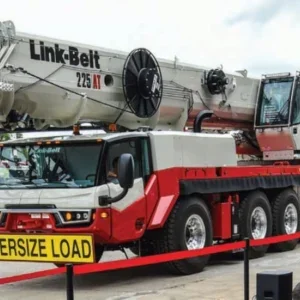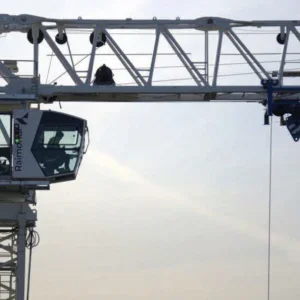ALE started life in 1983 as Abnormal Load Engineering, a comparatively small Staffords hire-based service engineering company that worked with utility firms and electrical goods manufacturers. While its official moniker has shortened, the company itself has grown into a global operation focused on the transportation and lifting of extraordinary loads.
For decades the transportation and heavy lifting specialist has had a strong presence across diverse industries from power generation and mining to shipbuilding.
Most notably though, the company regards itself as a world-leading contractor in the offshore petroleum sector, as it routinely handles the transportation and load-out of oil and gas platforms prior to offshore rig assembly.
And it is in this most promising sector for the lifting equipment industry that ALE intends to forge ahead of its competitors with its new Mega Jack system for lifting oil and gas platform modules weighing several tens of thousands of tonnes.
ALE engineers first gave the idea serious thought around six years ago as they realised that developments in the petroleum industry would necessitate bigger and bigger rigs.
Executive director for ALE in the Netherlands, Kees Kompier, explains: “In the early days the installation work was done by cranes. We were seeing a longterm need for increasingly bigger decks, but offshore lifting vessels are not capable of lifting and installing these bigger modules; you have to do it by means of a float-over, which always involves a jack-up operation. We didn’t feel any of the jacking systems currently available would be able to meet the changing requirements of the market as modules get bigger and bigger.”
Back in 2005 the size of investment needed to tap into deposits of petroleum located deep beneath the ocean floor made deepwater drilling operations commercially pointless.
However the inexorable rise in oil prices due to scarcity, exacerbated by the financial crisis, meant that petroleum’s commodity value was always destined to outweigh the investment cost of deepwater drilling.
For ALE this meant that investment in a 5,000t jacking unit, more powerful than anything currently on the market, was the only way to go to support current rig assembly techniques for topsides.
Kompier continues: “From that point our basic idea was to develop a 20,000t capacity jacking system, which consists of four towers of 5,000t each, that had a safe operational jacking height of 40m.”
ALE’s design for the Mega Jack is fairly simplistic. The system uses a minimum of four jacking bases, each one containing four 1,300t capacity hydraulic jacks with 1.25mm stroke lengths.
Above these are two starter beams, which are eventually jacked up to allow placement of the jacking beams below.
Initially these starter beams lie with each end inserted through temporary supports, which hold the load during insertion of each jacking beam, which are situated on top of each hydraulic jack.
When the starter beams are raised and held above the temporary supports by the hydraulic jacks, the supports, which are open on two parallel vertical sides, rotate on a turntable so that the closed sides lie at a right angle to the starter beams and thereby support the load.
At this point the hydraulic jacks are retracted to allow the insertion of two jacking beams through the open side of the supports, via two of four separate feed-in systems attached to the base.
As with the starter beams these jacking beams are jacked up, and the supports rotate to hold the load while aligning their open sides with the other two feed-in systems.
In this manner a freestanding foursided tower is formed at each corner below the load until it reaches the required height.
Initially, this target height was 40m for a 20,000t load, but after consultation with its client base in the offshore petroleum sector, ALE realised they could take the Mega Jack further.
“After we started marketing it to our clients they came back to us and we had a chat about the possibilities,” explains Kompier. “They said to us ‘it’s nice to have this 5,000t capacity, but on the bigger decks we would like to have capacity of 30,000t or 40,000t or 50,000t. Can you support us?’ so we started to look at our system and develop it further.”
“Now it’s actually a combination of three types of tower, the 5,000t tower, the 10,000t tower and a 15,000t tower.”
Each of these higher capacity towers essentially consists of two or more 5,000t base units combined.
This modular system design provides a great deal of flexibility when tailoring the jacking system to the particular load being raised, as different combinations of towers can be used. For instance a platform deck with an uneven centre of gravity may require two 5,000t jacking towers and two 10,000t towers to account for this.
This also adds to the system’s ease of transportation, as the Mega Jack can be disassembled and containerised for worldwide transport.
“In Korea they are constructing decks now up to 35,000t and 40,000t,” says Kompier. “China is busy developing those kinds of decks also, so there’s several places where they are being built now. If you give the engineers the possibility to build bigger they’re going do it.”
Another development to come out of ALE’s conversations with its clients was the need to engineer flexibility into the size of the tower, for jobs where a minimal tower footprint is required.
The standard base section dimensions are 5m x 5m, but similar lifting capacities can be achieved with the Mega Jack using 2.5m long jacking beams, cutting the footprint of a jacking base down to a quarter of its standard size.
At this point ALE says the Mega Jack is capable of lifting 40,000t weights safely to a height of 25m, but they are working on lifting large topsides as high as 50m.
With such enormous stresses on the jacking system, one of the most difficult challenges in the system’s development has been minimising risk during operation when strong winds pick up during lifting.
Kompier says the fundamental design of the system confers exceptional stability on the system, which can allow it to withstand extremely high additional loadings, even mid-jacking.
“That is the great thing about the system,” comments Kompier. “Due to the huge stability it has, the safety of the whole operation is so great that if something happens, like wind gusts starting up and we have huge wind loads, we may have to stop, but it’s just a matter of waiting, the stability is still there.”
The temporary supports are capable of holding the entire load, plus wind loadings for extended periods of time if necessary.
And judging by one theoretical case study Kompier refers to where a 38,000t load is lifted 35m by the Mega Jack, the system could easily withstand additional wind loadings of 50m/s at that height.
All of this data during each jacking operation will be collected by a specially designed control room on the Mega Jack, which will automatically monitor and provide precision control for every movement of the process.
With all data collected in the control room, its computer system will perform simulations using information about the current deck height, wind speed, ground settlement, and whether the tower is being erected 100% vertically to determine safe parameters for working.
Although a working version of the Mega Jack system has yet to be constructed, following the input from various client companies, ALE is very confident that the system will have a significant impact on the market.
ALE Executive director Ronald Hoefmans, who has also worked on the Mega Jack’s design said: “We expect a good market for it and we are confident in that market. We’re in contact with a lot of clients who are very happy with this new system because they can now build big modules and topsides and know there’s a system that can pick them up.”
“With this system in place we can do the whole project for our clientele. The only thing that was missing was the jack up system, so now they can have only one subcontractor to talk to who can give them the whole package of pulling the load-out, skidding the load-out and ballasting during the load-out and floatover operations.”
ALE is currently assembling the first Mega Jack system and plans to finish testing in May. The initial Mega Jack will be a four-tower system that should be ready for commercial use by December.
But this does not mean that ALE has finished tinkering with its new product.
While experimenting with different tower combinations, pushing for greater jacking heights, and attempting to lift even greater loads, ALE is also planning to add skidding beams to the system.
ALE believes the particularly high stability of the system lends itself to the integration of skidding beams into the jacking system to provide the option of skidding raised modules into place.
According to Kompier, such future developments could see the Mega Jack’s use widen from offshore platform assembly to many other applications.
“I can see it jacking up bridges prior to floating, that could be an option. We’re looking at ship conversions, small shipyards. For the moment offshore is the main focus, but in the longer term, you never know in our business.”






